Features
Sandra Caplan’s Jewish Journey
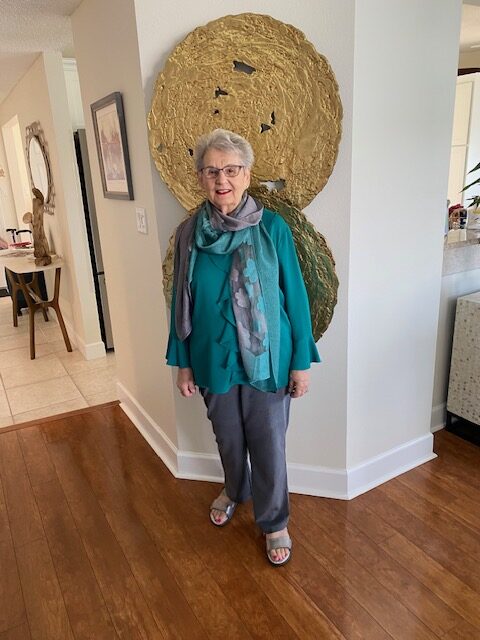
Recently we received an email from Sandra Caplan from her Florida wintertime home. Sandra told us that she had given a talk to her synagogue sisterhood about her life and wondered whether we might be interested in reprinting it.
Sandra’s life followed a path that would be familiar to many Winnipeg Jews (both present and former). So we thought it would be interesting to reprint the story of Sandra’s life here:
The following document, titled My Jewish Journey, was presented to the Sisterhood of Congregation B’nai Israel on March 10th, 2024. I hosted a brunch at my condo in St. Petersburg and spoke of “My Jewish Journey,” the current Rosh Chodesh topic. I am sending a copy of this to my family so that they will have a better understanding of my life. I wrote this in two sessions without an outline. The words flowed from my heart to my brain, my fingers and then to the written page. Please don’t fact find!!
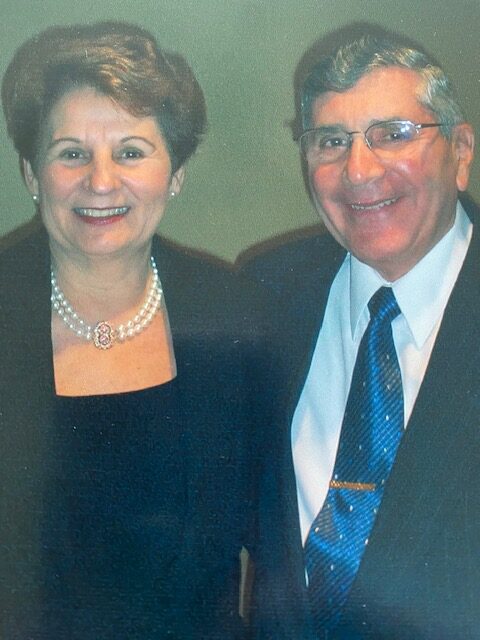
I had two photos that I always bring with me. One is of Barry and me, the other of my family on my eightieth birthday. I also had an atlas so I could show the Floridians where Winnipeg is located. Now on to my story.
The following document, titled My Jewish Journey, was presented to the Sisterhood of Congregation B’nai Israel on May 10th, 2024. I hosted a brunch at my condo in St. Petersburg and spoke of My Jewish Journey, the current Rosh Chodesh topic. I am sending a copy of this to my family so that they will have a better understanding of my life. I wrote this in two sessions without an outline. The words flowed from my heart to my brain, my fingers and then to the written page. Please don’t fact find!! I had two photos that I always bring with me. One is of Barry and me, the other of my family on my eightieth birthday. I also had an atlas so I could show the Floridians where Winnipeg is located. Now on to my story.
MY JEWISH JOURNEY
I am a Snowbird and live in Winnipeg, Manitoba, Canada. Before I speak of My Jewish Journey, I would like to give you a few facts about Winnipeg. It is in the center of Canada and is 2200 miles northwest of St. Petersburg and 500 northwest of Minneapolis. It is a prairie province, and the terrain is flat. The winters are so cold that we often plug our cars into an electric outlet, so that the engine doesn’t freeze. A mild day in the winter would be considered 0 F and a cold day 20 degrees below that. The population in Winnipeg is approximately 750,000 people.
Winnipeg has a Jewish population of about 8,000 people. However, in the 1930’s it was about 20,000. Many young people now leave for what they consider cities with more advantages, such as Toronto, Vancouver and many US cities. Also, families are now smaller. My Mother came from a family of seven and my father from a family of five. Winnipeg has been actively involved in promoting Winnipeg to the Argentinian Jewish community and now has a large group in our community. We also have a large French Canadian, Aboriginal and Filipina presence.
Growing up I always considered that Winnipeg had two areas that the Jewish people lived in-the north end and the south end. I was born in 1939 and lived in the north end. My first recollection is living in a duplex owned by my paternal grandparents who were born in Europe. I was told that the railway line at one point in time ended in Winnipeg and that is why so many Jewish immigrants settled there. Another reason was that there was a homestead plan offered in Manitoba through which new immigrants would be given a plot of land for free if they developed the land. As it turned out the winters were harsh, and the land was inhospitable. The Jewish immigrants were not necessarily experienced in farming and once settled gave up the concept. They turned to commerce and a large percentage of Manitoba’s small towns had Jewish owned general and other stores.
My father was born in Pinsk, Poland. In Winnipeg he became a furrier after high school. My mother was born in Winnipeg and opened a dress shop, Sandra’s, after I was born.
As a young child living on Flora Ave. In the early 1940’s, every house on our street was occupied by Jewish residents. At that time there were about eleven small Orthodox synagogues in the north end. I remember sitting in the balcony at the synagogue with my mother. It was a block from our home. My mother’s parents lived about 10 minutes from our home on Selkirk Ave. My grandmother was a milliner, and her shop was at the front of her home. When my paternal grandparents passed away, the house was sold, and we moved to the south end of the city. I was 5 and after that point can recall much of my Jewish Journey.
In 1945 the south end was considered an upscale area. By this time my father had a men and ladies clothing shop in the Time Bldg. on Portage Ave. My mother still had her shop, Sandra’s. Our family grew with the addition of my brother Frederick (Fred).
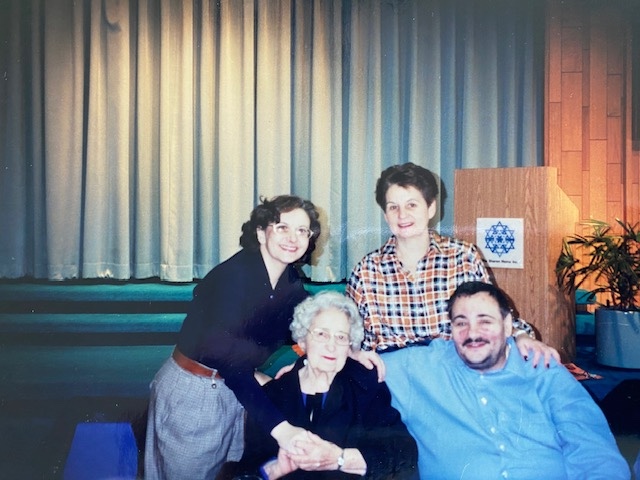
Our home on Oxford Street had several Jewish families. The school that I attended for grade one had very few Jewish kids. It was at the time that my parents decided it was time for my Jewish education to begin. There was not a synagogue in the area, but there was talk of the Shaarey Zedek, which we belonged to moving to the south end. So, as I entered grade two, my Jewish education began, and I attended after school Hebrew classes on Mondays and Wednesdays. The other 2 days were for the students in grades four to six. The classes were held in the basement of a home in the area.
My recollections of those days are quite clear. The kosher butcher delivered twice a week. Since my parents both worked, we had a housekeeper who was an excellent cook. On Friday nights we often had company for dinner. I was Jewish, went to Hebrew school had a strong sense of my religion, but attended the synagogue only on the High Holidays and celebrated other important holidays such as Pesach and of course, Chanukah.
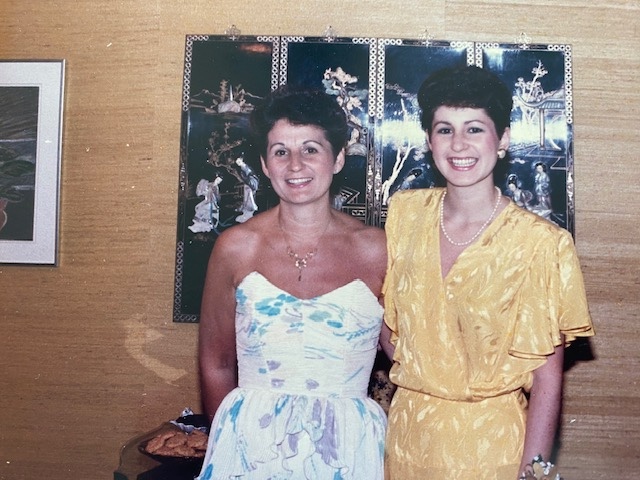
In 1949 my sister Marcia was born. In 1950 my father won the Irish Sweepstake. It was a grand sum of $39,500.00. I tried to translate it to today’s dollar. My thinking was that our home at that time cost $12,500.00. We could have bought 3 homes. That large home today of 4 bedrooms, a den and a finished basement could be worth $800,000. So, I estimate it was like winning $2, 400.000.00 today. With this fortune my father bought property on Portage Ave and built Fredric’s, a large store that sold ladies and men’s wear, sportswear, lingerie, had tuxedo rentals and had a bridal shop on the mezzanine floor.
It was about this time that the synagogue in the south end of town opened. It was a beautiful building on the river. I was able to attend Hebrew school here. It was a gathering place for Jewish children. I was a brownie and a girl scout, and both these activities were at the synagogue.
At that time the synagogue was the center of my Jewish and social life. In 1952 I had a Bat Mitzvah. This was a new ceremony at the conservative Shaarey Zedek synagogue. It was held on a Friday night. The Bat Mitzvah celebrant wore a loose, blue satin mid length long sleeved gown. It had a round collar and a white bow at the collar. I recall standing in front of the ark and reciting a prayer that started—O God and God of my Fathers. With grateful heart I stand before thee—. I also recited a haftorah which began-Vah yishlach Shlomo el Hiram laimor. Atah yadatah—. Obviously, I rehearsed this many times so that sixty-one years later I can still remember a small portion. After the service there was a reception in the social hall. We had party sandwiches, a Winnipeg specialty and favorite to this day, dainties as referred to by non Winnipeggers as squares and cookies and luscious cakes and cookies. Winnipeg Bar and Bat Mitzvah tables are well known in Canadian Jewish circles as are our baking is renowned. I can even remember several gifts that I received. A glass duck with a filling of bubble bath and a small wooden chest filled with note paper and envelopes. I still have that chest today. It was a glorious and happy celebration and did not end my Hebrew studies.
I continued going to Hebrew school until I was confirmed at the age of fifteen. For that ceremony I received a white leatherbound prayer book for the High Holidays which I still have today. When I was a teenager, I sang in the synagogue choir on Shabbat and the High Holidays. Our synagogue had a choir loft which was curtained and on the second floor behind the ark. We had about 20 members led by a choir master.
In Winnipeg in 1956 you could enter University after grade eleven, which I chose to do. So, I was sixteen when I enrolled at the University of Manitoba. Everyone with a few exceptions stayed at home to go to university. In those days we had one Jewish sorority, Iota Alpha Pi which I joined and became the president of in my second year of university. We also had 3 Jewish fraternities known as the Sammies, Zebes and Apes. I took Commerce but did not get my BCom because at the end of my third year I got my MRS.
So, this takes me to dating years in Winnipeg. My friends and I would never think of going out with anyone but a Jewish boy. We all married Jewish boys and married very young. I was nineteen when I married Barry who was a doctor and twenty-six years old. We had a large wedding at the Shaarey Zedek the synagogue that my family attended. Looking back, I feel that I was very young, unworldly leaving my parents to go to Los Angels where Barry would be a resident. I was a young girl in a new and different world! It was a challenge. Our Jewish life as we knew it was at a standstill. I had one Aunt and a few cousins that we could visit and we knew one couple from Winnipeg. There was no time to celebrate holidays and no one to really celebrate with.
California, however, was a nice place to live. We had no Winnipeg winters to deal with but also had no family to be with. Four years passed quickly, especially since we had two children. A daughter Susan who was born in 1962 and a son Bruce born in 1963. I also was fortunate to work at AT&T for 3 years.
Although as I previously said we felt like we had lost some of our Jewishness, a Bris was a ceremony that was very important to us. It was up to Barry to make the arrangements. He spoke to some of the Jewish attending doctors at the hospital. He got the name of a mohel and told my mother, who had come to help me, that the mohel had a request. The baby was to wear a cap and gown. I had no knowledge of Brises and my mother thought this was a little odd. However, we were in the United States. Traditions could be different. When Bruce was 4 days old a cousin came to babysit while my mother and I went shopping for a cap and gown. We found Christening gowns and other outfits for babies. Nothing was suitable for a Bris. I heard of a store in Long Beach that perhaps could help us in our search. I had never been to Long Beach but with directions managed to find the store. We found what we thought was a perfect outfit. It was a white cotton Carters gown that was tied at the bottom with a matching bonnet that was tied under the baby’s neck. The day of the Bris arrived and we met the Mohel. His first question to Barry was “did you bring my cap and gown from the hospital”. As an excited father Barry was so happy to find a Mohel he heard only the cap and gown and assumed it was for the baby. Fortunately, we lived a few minutes from the hospital and Barry was able to ge the cap and gown for the Mohel. Later the Mohel remarked that he thought the baby’s outfit was a little strange. Our first, but certainly not our last adventure with our son.
In 1963 we returned to Winipeg and a whole new Jewish Journey for me was established. Barry had a very large, observant family on his maternal and paternal side. So, I became immersed in all the Jewish culture of his family. My side of the family was small, and we were not as close as the Caplan/Stall family. I was twenty-three. A mother of two, naive, inexperienced and the product of a sheltered life. How did I survive? I guess that necessity was a factor. We adapted to life in the city, made friends, and carried on. The Caplan family belonged to the synagogue in the north end of town. My family belonged to the synagogue in the south end. Until our daughter Susan was twelve, we went to Rosh Pina with the Caplans. One incident that I clearly remember took place on the High Holidays in about 1969. We never joined the synagogue as Barry’s parents looked after our High Holiday tickets and with Barry’s work schedule as a Urologist who was on call every third weekend and every third of fourth night, he was not able to commit to going to shule. To get back to the holiday service the Rabbi spoke about membership in the synagogue and its importance in Jewish life. I felt he was looking directly at me as he made this appeal. On the way home I said to Barry that we must join the synagogue. It is a priority in our lives. As Susan’s Bat Mitzvah approached, I had a problem. Our children attended Ramah day school but lessons for your Bar /Bat Mitzvah and the ceremony, took place at the synagogue that you belonged to. In my mind I had no choice. To drive twice a week to the north end when it could be very cold, icy streets and a huge distance of a half hour was beyond my scope of reality. So, we joined the south end Shaarey Zedek Synagogue. Our son Bruce had his Bar Mitzvah in 1976 at the Shaarey Zedek and our son David who was born in 1971 completed this cycle.
While raising my family I was involved in Hadassah and National Council of Jewish Women. I became president of the chapters that I belonged to and was actively involved in both. I also volunteered at the Shaarey Zedek in a lunch program for seniors. Being in shule, whether as a volunteer or at a service or program was always an important part of my life. When my husband Barry retired in December 1999 we started coming to St. Petersburg for the winter. One of our first projects was to find a conservative synagogue. How fortunate we were to discover CBI.When we got home that spring, we started going to service every Saturday and this continued until Barry’s passing. I continued to attend until Covid and the two-year remodeling of our synagogue began. Our renovations are almost complete, and my family and I will be able to return to our beloved Shaarey Zedek for the holidays this year and I will return to my weekly Saturdays at shule.
Jewish holidays are a special time in our family. Last Rosh Hashanah my daughter Susan and I continued the family tradition of a luncheon on the first day of the holiday. This was held at her home. How wonderful that first to fourth cousins, machatunim and those close to the family gather to enjoy this holiday. I have been in touch with a cousin in Winnipeg to check on the first Seder for this year. My children are coming to Winnipeg from Vancouver, and we look forward to enjoying the Seder with the extended family again. This year we will probably have thirty attending but often there are many more.
When I speak of the synagogue and the importance of it in our family life, I cannot help but think of the day of Barry’s passing. I came into his hospital room and his first word was shule. I immediately called the synagogue, spoke to Rabbi Green and within a half hour he was at Barry’s bedside, singing and reciting prayers. How fortunate we are to have a religion and a life that makes us feel involved, loved and able to pass away in what we would consider a dignified and peaceful manner. As I write these words tears stream down my face and I realize how fortunate I am to have been born Jewish.
I truly feel that I could end my Jewish Journey here, but life goes on after the loss of loved ones. For six and a half years I have been a widow. My friends hate that word, but I can’t say that I am alone. That is not true. I have a wonderful family, friends and a full life. I come to Florida for the winter, I can travel with my daughter, I visit my children and grandchildren in Vancouver, I enjoy the cultural life in my two favorite cities and much more.
I feel that life has been good to me. I have three children, six grandchildren, many friends, good health and the ability to enjoy life. I have truly been blessed.
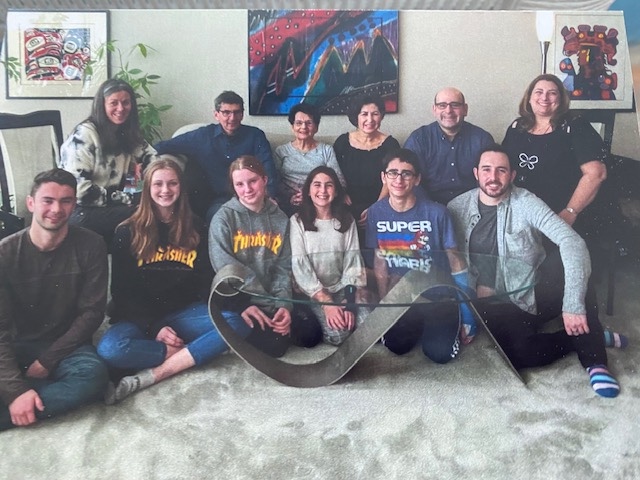
BACK ROW L – R: Sheri Winters, Bruce Caplan, Sandra Caplan, Susan Billinkoff, David Caplan, Cindy Switzer
Front Row L – R: Asher Billinkoff, Maia Caplan, Annie Caplan, Layla Switzer-Caplan, Max Switzer Caplan, Jordan Billinkoff
Features
A People and a Pulse: Jewish Voices in Jazz and Modern Music

By MARTIN ZEILIG Jazz history is usually told through its most iconic names — Armstrong, Ellington, Parker, Davis — yet running alongside that familiar story is another, often under‑acknowledged one: the deep and enduring contribution of Jewish musicians, bandleaders, composers, and cultural intermediaries.
From the moment jazz emerged at the turn of the 20th century, Jews were not simply observers but active shapers of the music and the industry around it. Their influence — artistic, entrepreneurial, and cultural — has been both significant and, in many respects, disproportionately large. Jews and Jazz (171 pg. $18.75 US) a self‑published work by Laurence Seeff, brings this parallel narrative into sharp, affectionate focus.
Seeff is an ideal guide.
Born in London in 1951, he built a career that moved from statistics to energy policy in Paris, from financial markets at Bloomberg to corporate training in the City of London, all while writing poetry, songs, and humorous verse. Today he lives in Israel, where he continues to write, perform, learn Ivrit, and enjoy life with his large family. Through all these chapters runs a constant passion for jazz — a passion sparked more than fifty‑five years ago when he first heard Terry Lightfoot’s Jazzmen in a Bournemouth pub.
His writing blends clarity, humour, and genuine love for the music and the people who made it.
The musicians he profiles often came from immigrant families who brought with them the musical DNA of Eastern Europe — the cadences of synagogue chant, the urgency of klezmer, the cultural instinct for learning and artistic expression. When these sensibilities met the African American genius of early jazz, the result was a remarkable creative fusion.
Some figures, like Chico Marx, are better known for comedy than musicianship, yet Seeff reminds us that Chico was a serious pianist whose jazz‑inflected playing appeared in every Marx Brothers film and whose orchestra launched young talents like Mel Tormé. Others — Abe Lyman, Lew Stone, and Oscar Rabin — shaped the dance‑band era on both sides of the Atlantic.
Canadian readers will be pleased to find Morris “Moe” Koffman included as well: the Toronto‑born flautist and saxophonist whose “Swinging Shepherd Blues” became an international hit and whose long career at the CBC helped define Canadian jazz.
Seeff also highlights artists whose connection to jazz is more tangential but culturally revealing. Barbra Streisand, for example — a classmate and choir‑mate of Neil Diamond at Erasmus Hall High School — was never a natural jazz singer, yet her versatility allowed her to step into the idiom when she chose.
She opened for Miles Davis at the Village Vanguard in 1961 and, nearly half a century later, returned to the same club to promote Love Is the Answer, her collaboration with jazz pianist Diana Krall. Her contribution to jazz may be limited, but her stature as one of the greatest singers of all time is unquestioned.
Neil Diamond, too, appears in these pages.
Though not a jazz artist, he starred — with gusto, if not great acting finesse — in the 1980 remake of The Jazz Singer, 53 years after Al Jolson’s original. The film was not a success, nor was it truly a jazz picture, but its title and its star’s Jewish identity make it part of the cultural tapestry Seeff explores.
Diamond and Streisand recorded together only once, in 1978, on “You Don’t Bring Me Flowers,” a reminder of the long‑standing artistic ties between them.
Mel Tormé, by contrast, was deeply rooted in jazz. Nicknamed “The Velvet Fog,” he was a prodigy who sang professionally at age four, wrote his first hit at sixteen, drummed for Chico Marx, and recorded with Benny Goodman and Artie Shaw. Ethel Waters once said he was “the only white man who sings with the soul of a black man.” His story exemplifies the porous, collaborative nature of jazz.
Seeff also includes non‑Jewish figures whose lives intersected meaningfully with Jewish culture. Frank Sinatra — perhaps the greatest crooner of them all — was a steadfast supporter of Jewish causes, from protesting during the Holocaust to raising funds for Israel Bonds and the Hebrew University. His multiple visits to Israel, including a major concert in Jerusalem in 1975, underscore the depth of his connection.
Danny Kaye earns his place through his close work with Louis Armstrong, his pitch‑perfect scat singing, and his starring role in The Five Pennies, the biopic of jazz cornetist Red Nichols. Though not a jazz musician per se, his performances radiated a genuine feel for the music.
A later generation is represented by Harry Connick Jr., whose Jewish mother and New Orleans upbringing placed him at the crossroads of cultures. A prodigy who played publicly at age five, he went on to become one of the most successful jazz‑influenced vocalists of his era, with ten number‑one jazz albums.
Even Bob Dylan appears in Seeff’s mosaic — another reminder that Jewish creativity has touched every corner of modern music, sometimes directly through jazz, sometimes through the broader cultural currents that surround it.
Taken together, the concise portraits in Jews and Jazz form a lively, engaging mosaic — a celebration of creativity, resilience, and cross‑cultural exchange. They show how Jewish musicians helped carry jazz from vaudeville and dance halls into swing, bebop, cool jazz, pop, rock, and film music.
They remind us that jazz, at its heart, is a meeting place: a space where people of different backgrounds listen to one another, learn from one another, and create something larger than themselves.
For further information, contact the author at the following email address: laurenceseeff@yahoo.co.uk
Features
Jews in Strange Places
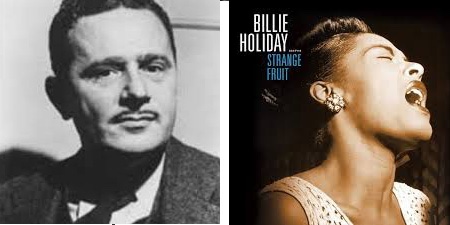
By DAVID TOPPER The Jewish contribution to 20th century popular music is well known. From Jerome Kern through to Stephen Sondheim, Jews played major roles as both composers and lyricists in the so-called Great American Songbook. (An exception is Cole Porter.) It continued in Musical Theatre throughout the rest of the century.
One very small piece of this story involves what Time magazine in the December 1999 issue called “the tune of the century.” First recorded sixty years before that, it is the powerful and haunting tune called “Strange Fruit,” which is about the lynching of black people in the southern USA. First sung by Billie Holiday in 1939, it became her signature tune.
So, why do I bring this up? Because there is a multi-layered Jewish connection to this song that is worth recalling, which may not be known to many readers.
Let’s start with the lyrics to “Strange Fruit,” which are the essence of this powerful piece:
Southern trees bear strange fruit,Blood on the leaves and blood at the root,Black bodies swinging in the southern breeze,Strange fruit hanging from the poplar trees.Pastoral scene of the gallant south,The bulging eyes and the twisted mouth,Scent of magnolias, sweet and fresh,Then the sudden smell of burning flesh.Here is fruit for the crows to pluck,For the rain to gather, for the wind to suck,For the sun to rot, for the trees to drop,Here is a strange and bitter crop.
Before becoming lyrics in a song, this poem stood alone as a potent statement about the lynchings still taking place throughout the American South at the time. The strong metaphorical imagery never explicitly mentions the lynching, which adds to the poetic power of this poem. Standing alone, I believe it’s an important protest verse from the 20th century.
Searching it on the internet, you may find the author listed as Lewis Allan. But that’s not his real name. “Lewis Allen” is the often-used pen name of Abel Meeropol, a Jewish High School teacher from the Bronx in New York. He and his wife, Anne (nee Shaffer), had two stillborn children with those names – a fact that adds a poignant element to this story.
The origin of the poem for Abel was a photograph he had seen of a lynching of black men in the South. I have seen such images, possibly even the one Abel saw: for example, a sepia photograph of two black men hanging from a long tree limb, and a large crowd of white people below (men, women and even children!), most seeming dressed in their Sunday best (some men with straw hats) looking up and gawking at the sight, some with smiles on their faces – as if attending a festive spectacle. Like Abel, I felt repelled by the picture: it turned my stomach. This communal display of horrific cruelty gave me a glimpse into Abel’s mind, and I understood how it compelled him to write about it. He thus wrote the poem, and it was published in a teacher’s magazine in 1937.
Being a songwriter too, in 1938 Abel added a melody and played it in a New York club he often attended. But here’s where this story’s documentation gets contradictory, depending upon who is recalling the events. The club owner knew Billie Holiday, and he showed the song to her. What her initial response was, we cannot know for sure. But we do know that in a relatively short time, she added it to her repertoire. It eventually became her signature tune. She initially sang it in public, but because of its popularity among her fans, there was pressure to record it too.
There were initial rejections from recording companies because of the controversial content. But Commodore Records took a chance and pressed the first recording in April 1939. This was the same year the movie “Gone with the Wind” came out; it was steeped in racial stereotyping. It was also sixteen years before Rosa Parks refused to give up her seat on a bus in Montgomery, Alabama.
As a record, the song obviously reached a large audience. Since the content was about racism, the song was seen as politically radical; not surprisingly, many radio stations banned it from the airwaves.
Furthermore, it’s also not surprising that Abel, a schoolteacher, was called to appear before a committee of New York lawmakers who were looking for communists in the schools. Possibly they were surprised to find that the poem and the song were written by a white man – and a Jew to boot. In particular, they wanted to know if he was paid by the Communist Party to write this song. He was not. And, in the end, they let him go. But shortly thereafter he quit his teaching job.
This took place in 1941 and was a precursor to the continued American obsession with communism into the 1950s, under Senator Joe McCarthy.
Indeed, that episode had an impact on Abel and Anne too. In 1953 Julius and Ethel Rosenberg were convicted of giving information about nuclear science to the Soviet Union, and they were the first married couple to be executed in the electric chair. They left two sons, Michael (age 10) and Robert (age 6). Apparently, immediate family members were reticent to get involved with the boys, possibly afraid of being accused of sympathizing with communism.
Enter Abel and Anne. Without a moment’s hesitation they stepped in, taking and raising the boys. As Michael and Robert Meeropol they eventually went on to become college professors – and naturally were active in social issues. Anne died in 1973. Abel died in 1986 in a Jewish nursing home in Massachusetts, after a slow decline into dementia. Long before that, Billie Holiday died in 1959, ravaged by the drug addition that took her life at forty-four years of age.
See why I called this a multi-layered Jewish story that’s worth telling?
To hear Billie Holiday singing “Strange Fruit” click here: Strange Fruit
Features
Is This the End of Jewish Life in Western Countries?

By HENRY SREBRNIK “Globalize the Intifada” has been the chant echoing through streets since October 7th, 2023. It was never a metaphor, and we now see the gruesome results across the western world, from Australia to Canada: the rise of groups of large, active networks of Islamist and anti-Zionist organizations.
Jews in the West are discovering that the nations they defended, enriched, and profoundly shaped have become increasingly inhospitable. After the Holocaust, explicit Jew-hatred became unfashionable in polite society, but the impulse never disappeared. The workaround was simple: separate Zionism from Judaism in name, then recycle every old anti-Jewish trope and pin it on “the Zionists.”
We have seen the full legitimization of genocidal anti-Zionism and its enthusiastic adoption by large segments of the public. The protests themselves, as they began immediately on October 7th, were celebrations of the Hamas massacres. The encampments, the building occupations, the harassment campaigns against Jewish students, the open calls for intifada, the attacks on Jews and Jewish places have become our new norm. History shows us that antisemitism does not respond to reason, incentive or the honest appeals of the Jewish community.
Outside the United States, there is no Western political establishment with either the will or the capability to address this problem, let alone reverse its growth. I’m sorry to say this, but the future of Western Europe, Canada, Australia, and New Zealand is likely to be increasingly Jew-free.
Today, police stand and watch mobs chant for Israel’s destruction, call for the genocide of its people, harass visibly Jewish citizens, and drive antisemitic intimidation deep into urban life. They now believe their job is to enforce the law only if it does not risk upsetting violent constituencies. This makes Jews expendable, because defending them risks confrontation. This was very clear in the Bondi Beach massacre.
Jews are again donning caps instead of kippot, dressing generically with no cultural markers, and avoiding even a tote bag with Hebrew on it. A corrosive creep toward informal segregation in retail and service sectors is occurring, as Jewish customers report being refused service. A mezuzah hanging from a rideshare mirror leads to cancellations. When Jews express frustration, they are accused of exaggeration or attempting to suppress criticism of Israel. Jewish fear is not treated as a real problem.
“Jews Are Being Sent Back into Hiding,” the title of a Dec. 15 article in the New York Free Press by David Wolpe and Deborah Lipstadt, asserts that the attacks on Jews, including physical assaults, social media campaigns and, most tragically, the recent murders in Australia, are part of a purposive campaign designed to make Jews think twice about gathering with other Jews, entering a synagogue, going to kosher restaurants, putting a mezuzah on the doorpost of their apartments or dorm rooms, or wearing a Jewish star around their necks.
“We know of no one who would consider giving a niece, nephew, grandchild, or young friend a Jewish star without first asking permission of their parents,” they write. The unspoken, and sometimes spoken, question is: “Might wearing a star endanger your child’s well-being?”
Recently, a prominent American rabbi was entering a Target store in Chicago with her grandson, whom she had picked up from his Jewish day school. As they walked into the store the 10-year-old reached up and automatically took off his kippah and put it in his pocket. Seeing his grandmother’s quizzical look, he explained: “Mommy wants me to do that.”
Borrowing a phrase from another form of bigotry, they contend that Jews are going “back into the closet.” No public celebration of Hanukkah took place in 2025 without a significant police presence. Some people chose to stay home.
Lipstadt and Wolpe know whereof they speak. They are respectively a professor of history and Holocaust studies who served as the Biden administration’s ambassador tasked with combating antisemitism, the other a rabbi who travels to Jewish communities throughout the world, and who served on Harvard’s antisemitism task force in the aftermath of the October 7, 2023 pogrom.
What the world has seen over the past two years is a continual, often systematic attempt to terrorize Jews. When political leaders fail to condemn rather than merely “discourage” chants of “globalize the intifada,” we are seeding the ground for massacres like the Hannukah one in Sydney.
If each Jewish holiday will now be seen by antisemites as an opportunity for terror, then the prognosis for diaspora Jewry is bleak. There will be fewer public events, more alarms, more bag checks at doors; there will have to be more security and more police. Unless things change, Jewish life in the diaspora will become more sealed off from the larger society.
Why has this failure come about? Confronting antisemitism, stopping the mobs, challenging the activists, and disciplining antisemitic bureaucrats all carry electoral risk for politicians; Jews are demographically irrelevant, especially compared with Muslim voters, with the U.S. being the only partial exception.
There are those who suggest Jews stop donating funds to educational and other institutions that have turned against us. At this point, I doubt very much that withdrawing dollars will have an impact. For every dollar withdrawn, there will be 100 from Qatar and other sources in its place.
Throughout history, the way a society treats its Jews predicts its future with unerring accuracy. If Jews leave, it will be because a civilization that will not defend its Jews will also defend next to nothing and may itself not survive.
Henry Srebrnik is a professor of political science at the University of Prince Edward Island







